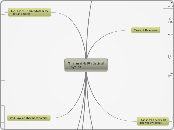by Phill Hamnett 14 years ago
1226
Thermal & Statistical Physics mbcx8ph2

by Phill Hamnett 14 years ago
1226

More like this
Statement of the law:
In a system, a process that occurs within a closed system will tend to increase the entropy of the system and entropy can never decrease.
The statement is an equality if the process is reversible.
Van der Waals argued that the pressure, P_attraction, is the result of mutual attraction between bulk of gas and a sample near the boundary, and hence should be proportional to the product of their densities.
This approximation treats the atoms as hard-spheres. Therefore, it is necessary to exclude the volume of the atoms.
In the equation I have replaced d-bar with delta's, hopefully it won't confuse people.
Phase Equilibrium occurs when all intensive variables of the two phases are equal. This can be proved by the second law of thermodynamics and by considering the multi-phase flow as a closed system.
This is for a single-particle species system only. There is a subsequent extension to this relation for multi-particle species system, however I don't think we need to know it.
The macrostate of a given thermodynamic system is give by simply a few thermodynamic variables, though like, P, V, T and state functions such as E and S. In other words, it's the collective behaviour of the substance.
A microstate of a thermodynamic system is the total states of each individual particle, therefore giving a total description of the gas in question.
In a qunatum mechanical description, particles are described by wavefunctions which are specified by the set of quantum numbers, n l, m_l, and small_omega (the spin).
For N quantum particles in a box, each state is a plane wave solution, and hence we can use three discrete components of momenta. We use these collection of quantum numbers to form the microstate. This is known as the independant particle approximation, as it ignores the interactions between particles.
In a classical mechanics description, a particle can be described entirely by it's position and momentum. So for N particles, since we have 3 spatial dimensions and 3 momenta dimensions for each particle, the combination of these 6 dimensions for each particle make up what's known as phase space, which is a 6N dimensional space.
Omega is the number of microstates in the given system.
Using this equation, we can expand all of the thermodynamic potentials in terms of their total differential components, and simply compare the coefficients with the ones defined from the fundamental thermodynamic relation to yield a pair of equations that must be true.
At constant pressure, the change in heat is equal to the change in enthalpy. This value is known as the latent heat.
4th Maxwell Relation
This definition is useful for phase transitions, since the Gibbs free energy is always constant at this point (ie, when T and P are fixed).
3rd Maxwell Relation
This definition is useful for systems of constant temperature.
To find the differential forms, differentiate with respect to a random variable, say x for this example, assuming all of the functions are functions of x. Then multiply by dx to eliminate the random variable.
2nd Maxwell Relation
To derive one of the Maxwell equations, follow the following steps:
You'll be required to derive these in the exam.
The "natural" variables of E are S and V, as the infinitesimal change of E depends on the changes of these two variables.
The Carnot Cycle is as follows:
•
• Reversible isothermal expansion of the gas at the "hot" temperature, T1 (isothermal heat addition). (1 to 2 in image.)
• Isentropic (reversible adiabatic) expansion of the gas (isentropic work output). (2 to 3 in image.)
• Reversible isothermal compression of the gas at the "cold" temperature, T2. (isothermal heat rejection). (3 to 4 in image.)
• Isentropic compression of the gas (isentropic work input). (4 to 1 in image.)
Information taken from:
http://en.wikipedia.org/wiki/Carnot_cycle
Although it's from wikipedia, I believe it's consistent with the course.
The carnot efficiency is independant of the substance used, therefore it can be derived by considering the process occuring through an ideal gas.
This can be obtained via the proof of Carnot's Theorem.